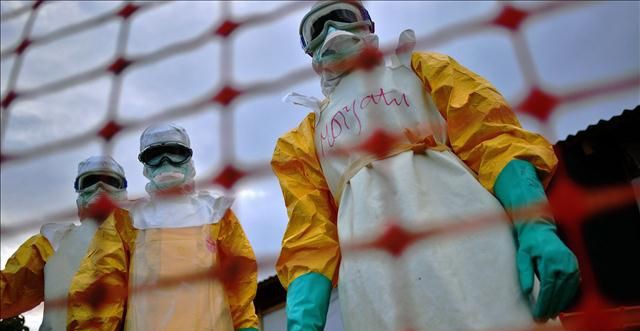
On Tuesday, the Democratic Republic of Congo (DRC) reported to the World Health Organization (WHO) that the country is experiencing an outbreak of Ebola, which officials say is likely separate and unrelated to the unprecedented outbreak in West Africa.
While we don’t have a lot of information yet, we do have a few key facts that can help us better understand how the virus spread in the DRC, how many people have been affected, and how health officials are responding to the emerging outbreak.
Here’s what we know so far:
1. The DRC has dealt with Ebola before

Because of West Africa’s lack of experience with Ebola, the virus was not initially recognized when the first deaths were reported. This gave the disease several weeks — possibly even months — to grow out of control before health officials had even implemented the first infection control measures. Even after the virus was confirmed to be Ebola, the region’s unfamiliarity with the virus made it difficult to establish an adequate response to the outbreak, contributing to the spread of the virus among the population as well as health care workers.
In contrast to the affected countries in West Africa, which had never seen Ebola until the current outbreak, this is not the first time the DRC has dealt with the deadly virus. In fact, this is the seventh outbreak of Ebola in the DRC, where the disease was first discovered in 1976. That outbreak — which took place in Yambuku and surrounding areas — sickened 318 people, killing nearly 90 percent of them (280). Congolese officials say the experience acquired during the six previous Ebola outbreaks will help them contain the virus before it grows out of control.
2. Animal-to-human transmission occurred via bush meat

As I’ve written about previously, Ebola is a zoonotic disease — one that can be transmitted between animals and humans. While scientists are still not entirely sure what animal(s) is the primary host of the virus, the main suspects are fruit bats and several types of primates.
According to the WHO, the first person to contract Ebola in the DRC (“Patient Zero”) was a pregnant woman who butchered a bush animal given to her by her husband. The consumption of bush meat is considered to be one of the main routes of animal-to-human transmission; however, in many areas of Africa bush meat is also a life-saving source of nutrition where other sources of protein from domesticated animals are scarce or prohibitively expensive.
3. Human-to-human transmission occurred among health care workers, caregivers, and family

Human-to-human transmission of Ebola results from direct contact (through broken skin or mucous membranes) with the blood, secretions, organs or other bodily fluids of infected people, and indirect contact with environments contaminated with such fluids. Health care workers and caregivers have been hit hard by the outbreak in West Africa, and a similar pattern is emerging in the DRC.
Patient Zero was taken to a clinic after she started displaying symptoms of Ebola virus disease and died on Aug. 11 of a hemorrhagic fever, that at the time, was not yet identified as Ebola, the WHO says. The health care workers who cared for the woman, which included one doctor, two nurses, a hygienist and a ward boy, all developed similar symptoms and died. Similar deaths were discovered among relatives of the first pregnant woman, people who were in contact with the health care workers, and people who were involved in the burial process of all the men and women who died.
4. Two dozen cases, more than half resulting in death

Ebola is a deadly disease, killing up to 90 percent of those infected with the virus. The majority (about 60 percent) of Ebola patients in West Africa’s outbreak have died, and the DRC is reporting similar numbers.
From July 28 to August 18 there have been 24 suspected cases of the virus in the DRC, which includes 13 deaths, the WHO says. However, the actual figures could be higher: The affected area has reported more than 70 deaths due to an unknown hemorrhagic fever in recent weeks, and officials say it is possible that some of those deaths were actually caused by Ebola.
5. Preliminary tests revealed a different strain of Ebola is causing the outbreak

Currently, three strains of Ebola virus are known to cause illness in humans: The Zaire, Sudan, and Ivory Coast Ebola virus strains, named for the respective regions in Africa in which the strain was found.
According to Dr. Felix Kabange Numbi, DRC health minister, blood tests revealed that the outbreak in the DRC stems from two different strains of the virus. One of the cases that tested positive was for the Sudanese strain of the disease, while another was a mixture between the Sudanese and the Zaire strain – the most lethal variety, Congolese health officials said. The outbreak in West Africa is the Zaire strain.
*****
The Democratic Republic of Congo Ministry of Health is currently monitoring the situation and is undergoing contact tracing with support from WHO. Meanwhile, the WHO released a new report this week highlighting the “unprecedented” spread of Ebola among health care workers. So far, at least 240 health care workers in Liberia, Sierra Leone, Guinea, and Nigeria have been infected with the virus, and half have died from it. The WHO cites several factors that could help explain the high proportion of infected medical staff. These include “shortages of personal protective equipment or its improper use, far too few medical staff for such a large outbreak, and the compassion that causes medical staff to work in isolation wards far beyond the number of hours recommended as safe.”
